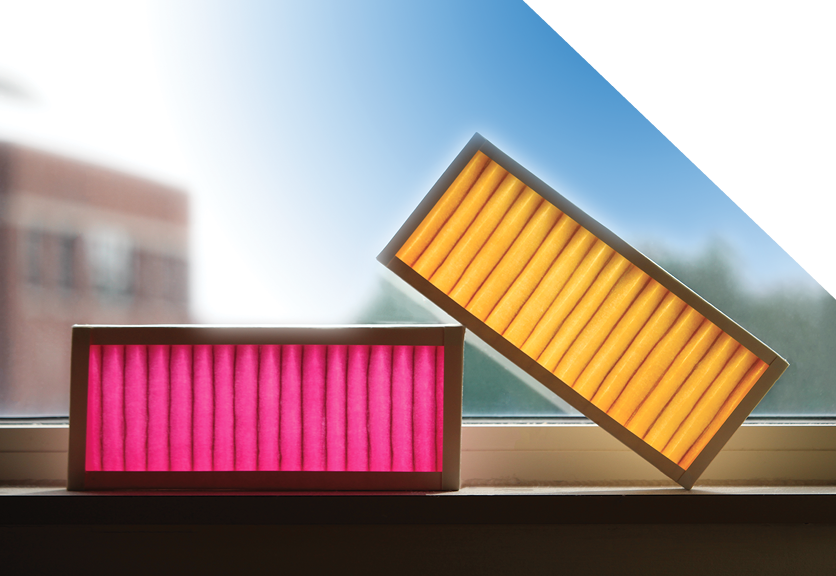
Spacesuit Air Filters Eliminate Household Pet Odors
NASA Technology
In a surprising turn, NASA-backed research on new spacesuit technology could improve air quality in the homes of pet owners, as well as keep cars smelling fresh and filter contaminants out of the air in microchip manufacturing facilities.
The technology has been under development for some time. After creating an air and water purification system as PhD students in the Materials Science and Engineering Department at the University of Illinois at Urbana-Champaign, James Langer and Weihua Zheng cofounded Serionix Inc. in 2011 to bring their research out of the lab and into the world. They quickly narrowed their focus to air purification.
“We found a special formula—our secret sauce—that was highly reactive to certain toxic or otherwise unwanted chemicals in the air,” says Langer, who is now president of Serionix. The formula, the company’s patent-pending Colorfil technology, involves polyelectrolytes—polymer substances with a permanent electrical charge on them. It applies the coating to the surface of a fabric-like nonwoven material. The material is breathable and easily installed, like a regular air filter, and the Colorfil coating removes toxic chemicals and kills viruses, bacteria, and mold.
Langer and Zheng were researching applications for their air purification technology when they came across a NASA solicitation for research on spacesuit air quality, primarily for the safety, health, and comfort of the astronauts.
Technology Transfer
Johnson Space Center awarded Serionix, located in Champaign, Illinois, a Small Business Innovation Research (SBIR) contract in 2016 that provided about $125,000 to design and demonstrate a lightweight, high-performing system for removing ammonia and formaldehyde from next-generation spacesuits.
Later that year, after proving the technology, the company won another $750,000 from Johnson in SBIR Phase II funding to tailor the filters to spacesuit and spacecraft requirements. An SBIR Phase III award from Johnson has enabled Serionix to focus on vehicle air quality challenges, mainly for Orion, which is NASA’s first spacecraft designed to carry astronauts since the retirement of the Space Shuttle in 2011.
“The challenges that we’ve been working on with NASA are mostly to do with the engineering challenges of actually incorporating the technology in the suit or in space vehicles,” Langer says. “Weight and shape and ease-of-use constraints all become critical issues in these applications.”
In a spacesuit, the suit itself could be the source of the air contaminants, or the human body could cause buildup of ammonia and toxins over time, just from offgassing. How much ammonia is present will vary depending on the age of the spacesuit and on the individual in it—their physical state, what they’ve eaten.
Serionix’s Colorfil technology also changes color when a filter is spent, which prevents unnecessary changes, such as when filters are swapped at predetermined intervals. Unlike traditional filters that start out white and turn gray over time, Serionix filters change unambiguously from bright magenta to a drab yellow.
“The idea was to put a filter in a spacesuit or on the International Space Station or Orion that would give clear feedback to users when it needs to be replaced,” Langer says.
“It could be that the first few uses of a new spacesuit might use up a new filter, but then later in the spacesuit’s life, it might be more like 10 uses,” Langer says. “So instead of having to arbitrarily replace it on a schedule, our filter would allow you to use a more rational approach, replacing it when needed.”
Benefits
When Langer and his colleagues at Serionix began considering potential applications for their filters, two distinct directions emerged. They could go high-tech, filtering air in space, and they could target consumers directly. Ultimately, the company decided to pursue both paths.
“The aerospace direction for our technology was pretty straightforward,” he says. “Interestingly enough, we found that on the far extreme, the consumer side of things, ammonia happened to be a real issue with pet owners in particular.”
Unpleasant odors from cat boxes, hamster cages, and other pet spaces is due to ammonia and other related chemicals in urine that Serionix filters excel at removing. The company received encouraging feedback after conducting beta testing with consumers using their filters in air purifiers and HVAC filters.
Serionix currently sells these household filters directly to consumers through the company’s website. Products include a Colorfil-branded air purifier, an HVAC filter, and a cabin air filter for automobiles. All the products incorporate Colorfil filter technology that changes from magenta to dull yellow and promises to remove chemicals and odors from the air that other filters can’t.
The company has also been working with a microchip manufacturer, because that process is also highly sensitive to ammonia and other corrosive gases. Langer and his team have also been in talks with an automaker to provide car cabin filters on a large scale.
Besides NASA, the company has received research funding from the U.S. Army and the National Science Foundation. But Langer says the NASA contracts in particular have contributed to the development of the consumer applications.
“All of the challenges that we have here are simply magnified up in space. That’s the environment up there, and people’s lives depend on solving those problems,” he says. “The challenges of deploying the technology in space definitely serve us well in making a more robust product for our customers on Earth.”

Because microchips’ components are so small and sensitive, they must be manufactured in hyperclean environments, free of even tiny specks of dust or traces of harmful gases such as ammonia. Serionix is working with one microchip manufacturer to incorporate its filters in the company’s facilities.

Thanks to their chemical properties, Serionix Colorfil filters change from a vibrant magenta to a dull yellow when they need replacing, eliminating guesswork and saving money.

In a small, closed environment like the space station, keeping air clean and breathable is a serious chore. NASA astronaut Dan Burbank is shown here cleaning cabin air bacteria filters in the Tranquility node of the station in 2012.













